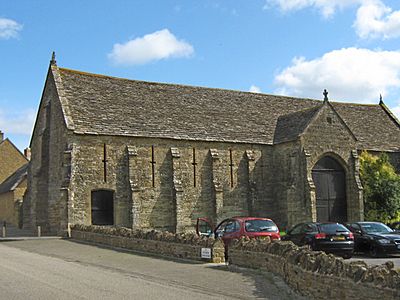Monastic grange facts for kids

Monastic granges were like special farms or estates owned by monasteries. These farms were separate from the usual manor system where lords owned the land. Monasteries used granges to grow food and produce goods for their communities.
The first granges were started by a group of monks called the Cistercians. Other monastic groups soon began to have their own granges too. Rich monasteries often owned many granges. Most of these granges were used for farming. They provided food for the monks and nuns living in the monastery.
Some granges were built right next to the monastery. But others were far away, wherever the monastery owned land. Workers at these granges could be lay brothers, who were part of the monastic order but not monks. Sometimes, paid workers also helped run the granges.
Granges came in different types. Some were for growing crops, like a regular farm. Others were for raising animals, such as sheep, cattle, or even horses. Some granges focused on fishing. There were also "industrial" granges. These were important for developing medieval industries, especially working with iron.
What Were Monastic Granges?
Granges were large pieces of land used to produce food. Each grange had a main farm building and other smaller buildings. It might also have a mill for grinding grain or a large barn for storing crops. The word "grange" comes from the French word graunge. This word means "granary," which is a place to store grain.
Granges could be located far from the monastery. They were used for both raising animals and growing crops. Sometimes, they grew special crops like apples, hops (used for making beer), or grapes for wine. Some granges even had fish-ponds. These ponds provided fish for the monastery's meals, especially on Fridays.
The food and goods produced at granges helped feed the monks and nuns. Any extra produce could be sold to make money for the monastery. A manager, called a steward, often ran the grange. Local farm workers or lay brothers did the work.
Monastic Granges in England
During the time of the Dissolution of the Monasteries, King Henry VIII took control of all monastic lands in England. This happened in the 1530s. After taking the land, the King sold it off.
Even after being sold, many granges kept their original names. You can still find places called "Grange" in the British countryside today. These names remind us of the important role these farms played in medieval times.
See also
 In Spanish: Granja monástica para niños
In Spanish: Granja monástica para niños

